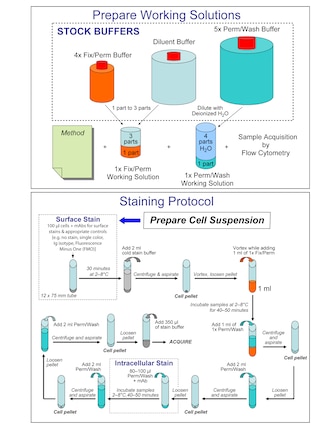-
Your selected country is
Middle East / Africa
- Change country/language
Old Browser
This page has been recently translated and is available in French now.
Looks like you're visiting us from {countryName}.
Would you like to stay on the current country site or be switched to your country?




Two color flow cytometric analysis of Blimp-1 expression in activated mouse splenocytes. Mouse splenic leucocytes were stimulated for 3 days with lipopolysaccharide and stained with FITC Rat Anti-Mouse CD45R/B220 antibody (Cat.No. 553088/553087/561877). The cells were subsequently fixed and permeabilized with the BD Pharmingen™ Transcription Factor Buffer Set (Cat. No. 562574/562725) and stained with either BD Horizon™ BV421 Rat IgG2a, κ Isotype Control (Cat. No. 562602; Left Panel) or BD Horizon BV421 Rat Anti-Mouse Blimp-1 antibody (Cat. No. 564270; Right Panel). Two-color flow cytometric contour plots showing the correlated expression of Blimp-1 (or Ig Isotype control staining) versus CD45R/B220 were derived from gated events with the forward and side light-scatter characteristics of intact activated splenocytes. Unstimulated splenocytes show a staining pattern similar to Ig Isotype stained cells (data not shown). Flow cytometric analysis was performed using a BD™ LSR II Flow Cytometer System.


BD Horizon™ BV421 Rat Anti-Mouse Blimp-1

Regulatory Status Legend
Any use of products other than the permitted use without the express written authorization of Becton, Dickinson and Company is strictly prohibited.
Preparation And Storage
Product Notices
- Since applications vary, each investigator should titrate the reagent to obtain optimal results.
- An isotype control should be used at the same concentration as the antibody of interest.
- Caution: Sodium azide yields highly toxic hydrazoic acid under acidic conditions. Dilute azide compounds in running water before discarding to avoid accumulation of potentially explosive deposits in plumbing.
- Source of all serum proteins is from USDA inspected abattoirs located in the United States.
- Pacific Blue™ is a trademark of Molecular Probes, Inc., Eugene, OR.
- For fluorochrome spectra and suitable instrument settings, please refer to our Multicolor Flow Cytometry web page at www.bdbiosciences.com/colors.
- Please refer to www.bdbiosciences.com/us/s/resources for technical protocols.
Companion Products






The 5E7 monoclonal antibody specifically binds to mouse B lymphocyte-induced maturation protein 1 (Blimp-1). Blimp-1 is a 98 kDa zinc finger-containing protein that is encoded by the Prdm1 gene and functions as a transcriptional repressor. Blimp-1 is essential for regulating the terminal differentiation of activated B cells into plasma cells. In this process, Blimp-1 suppresses genes involved in B cell proliferation, such as Myc and Bcl6. It controls other genes, such as Xbp1, that are required for upregulating the plasma cell's protein synthesis machinery which is essential for antibody production and secretion. Blimp-1 is an important regulator in other cell types as well. It functions in the regulation of T cell activation and homeostasis and NK cell maturation. Blimp-1 is expressed in activated T cells and can function to inhibit IL-2 production while enhancing the differentiation and expression of several molecules produced by effector T cells.
The antibody was conjugated to BD Horizon BV421 which is part of the BD Horizon Brilliant™ Violet family of dyes. With an Ex Max of 407-nm and Em Max at 421-nm, BD Horizon BV421 can be excited by the violet laser and detected in the standard Pacific Blue™ filter set (eg, 450/50-nm filter). BD Horizon BV421 conjugates are very bright, often exhibiting a 10 fold improvement in brightness compared to Pacific Blue conjugates.

Development References (9)
-
Crotty S, Johnston RJ, Schoenberger SP. Effectors and memories: Bcl-6 and Blimp-1 in T and B lymphocyte differentiation. Nat Immunol. 2010; 11(2):114-120. (Biology). View Reference
-
Huang S. Blimp-1 is the murine homolog of the human transcriptional repressor PRDI-BF1. Cell. 1994; 78(1):9. (Biology). View Reference
-
Johnston RJ, Poholek AC, DiToro D, et al. Bcl6 and Blimp-1 are reciprocal and antagonistic regulators of T follicular helper cell differentiation.. Science. 2009; 325(5943):1006-10. (Biology). View Reference
-
Kallies A, Carotta S, Huntington ND, et al. A role for Blimp1 in the transcriptional network controlling natural killer cell maturation. Blood. 2011; 117(6):1869-1879. (Immunogen: Western blot). View Reference
-
Kallies A, Hasbold J, Tarlinton DM, et al. Plasma cell ontogeny defined by quantitative changes in blimp-1 expression. J Exp Med. 2004; 200(8):967-977. (Biology). View Reference
-
Kallies A, Hawkins ED, Belz GT, et al. Transcriptional repressor Blimp-1 is essential for T cell homeostasis and self-tolerance. Nat Immunol. 2006; 7(5):466-474. (Biology). View Reference
-
Kim SJ, Gregersen PK, Diamond B. Regulation of dendritic cell activation by microRNA let-7c and BLIMP1. J Clin Invest. 2013; 123(2):823-833. (Biology). View Reference
-
Martins GA, Cimmino L, Liao J, Magnusdottir E, Calame K. Blimp-1 directly represses Il2 and the Il2 activator Fos, attenuating T cell proliferation and survival. J Exp Med. 2008; 205(9):1959-1965. (Biology). View Reference
-
Turner CA Jr, Mack DH, Davis MM. Blimp-1, a novel zinc finger-containing protein that can drive the maturation of B lymphocytes into immunoglobulin-secreting cells. Cell. 1994; 77(2):297-306. (Biology). View Reference
Please refer to Support Documents for Quality Certificates
Global - Refer to manufacturer's instructions for use and related User Manuals and Technical data sheets before using this products as described
Comparisons, where applicable, are made against older BD Technology, manual methods or are general performance claims. Comparisons are not made against non-BD technologies, unless otherwise noted.
For Research Use Only. Not for use in diagnostic or therapeutic procedures.
Report a Site Issue
This form is intended to help us improve our website experience. For other support, please visit our Contact Us page.